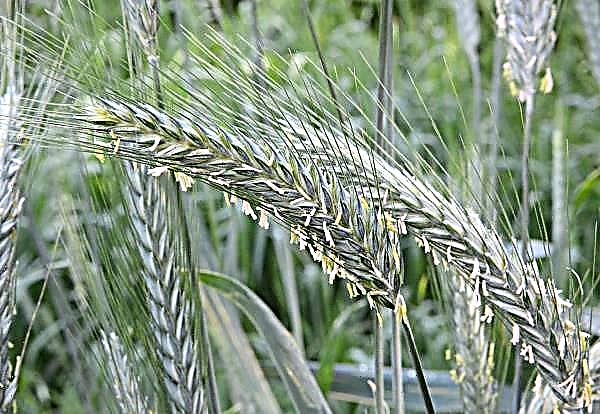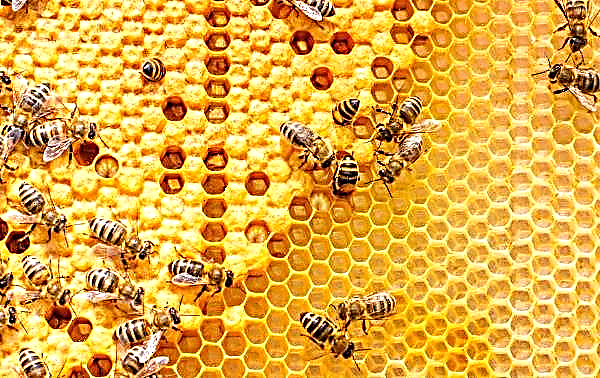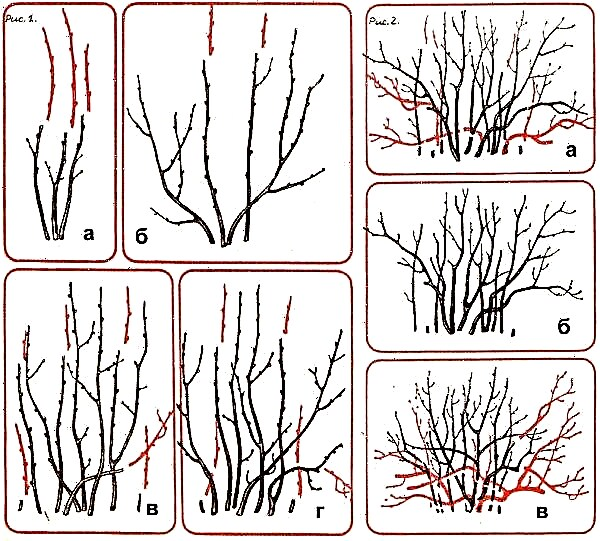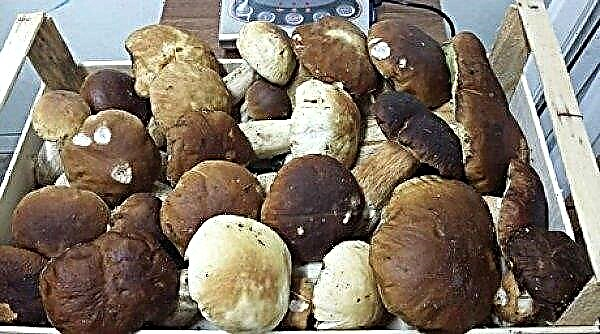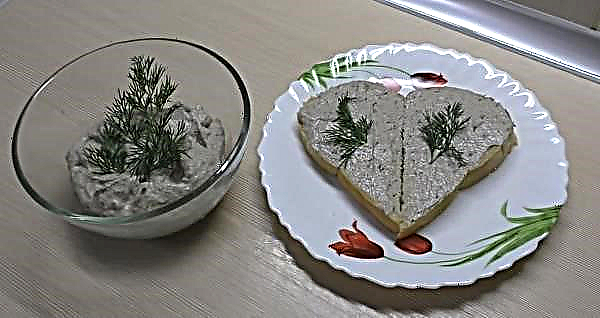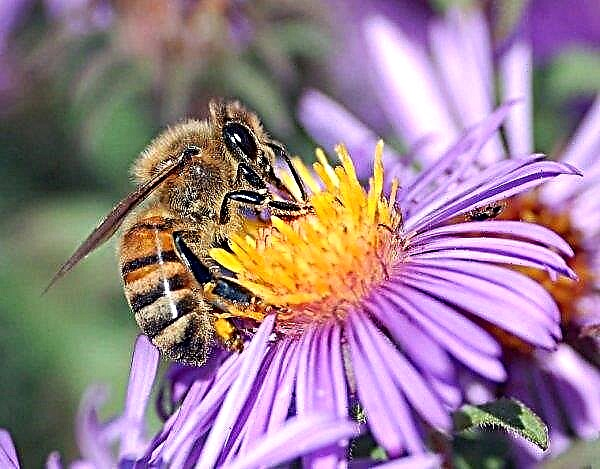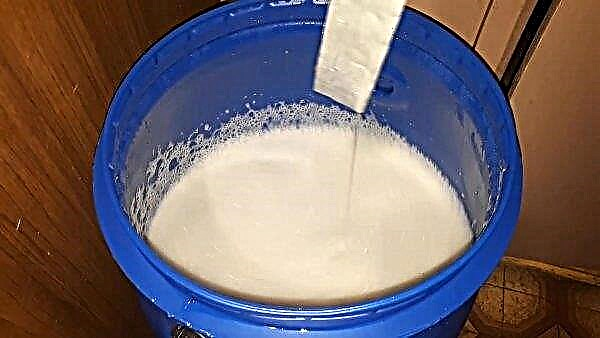When it comes to indoor floriculture, many people prefer to grow plants that are easy to care for. Ariocarpus (Ariocarpus) can not be called very easy to care for. It is grown due to its unusual appearance, beautiful flowering and compactness. The features of growing cactus without thorns will be discussed in this review.
Ariocarpus: plant description
Ariocarpus belong to the Cactus family. The homeland of the plant is in the territory of modern USA and Mexico. This is one of the most unusual and attractive cacti. In some of its species, the stems grow almost at ground level. They are flattened, triangular in shape, gray-green in color, slightly thickened. At the ends of the stems there are rudimentary “spiny thorns”. With the exception of the earliest months of growth, mature plants do not have thorns.
The root system resembles a pear or turnip with additional peripheral filiform roots. The root of this succulent is about 80% of its size. All types of ariocarpuses are compact. The largest of them grow up to 7 cm in height and up to about 25 cm across. The rest of the sizes are more modest. In shape, the plant approaches a hemisphere or spherical shape.
In adulthood, the ariocarpus remains a single plant, but some species can produce clones or compact additional clusters of several stems. Due to the very low growth and almost gray color of the stems, most ariocarpuses are well masked in the habitat. They are almost impossible to detect if the plant is blooming.
Flowers are the main decoration of a cactus. They can be white, yellow or red. Diameter - up to 5 cm. Flowering occurs at the beginning of autumn - September or October. Some species bloom in November. The duration of flowering is only a couple of days. The faded flower forms a small green round fruit with a diameter of 5–20 mm. Inside the fruit are small seeds. As it ripens, the fruit breaks up and the seeds spill out into the ground.
Did you know? The top of the ariocarpus may have a thick coat, similar to wool. It is designed to protect the cactus from the scorching sun, drying out and other stressful environmental factors.
In total, more than 10 species of these interesting cacti are known.
Characteristics of the main ones:
- Ariocarpus agave - a plant with a small green juicy rosette with stems of greenish-brown color up to 6 cm long and 8 cm in diameter. As it grows, the lower part of the trunk gradually lignifies. In shape resembles a star with thickened rays directed in different directions from the central axis. Flowering is possible at 5–8 years of age. The flower of a dark pink (purple) color reaches a diameter of 3-4 cm, similar in shape to a bell. Grows on rocky limestone hills and alluvial plains. It is considered almost extinct due to over-gathering by people, the development of agriculture and the eating of farm animals.
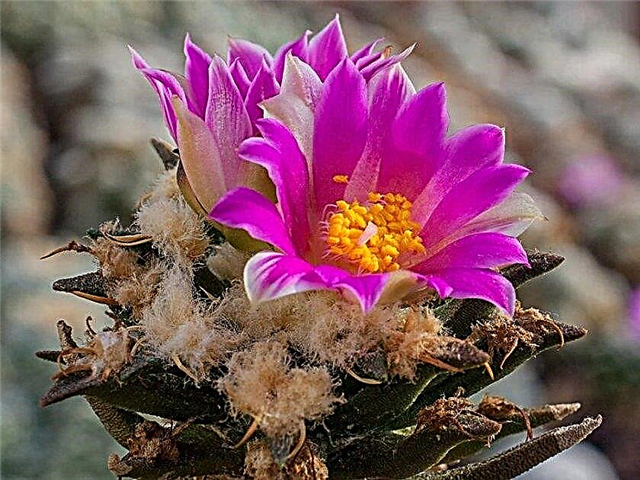
- Ariocarpus blunt - one of the largest species (diameter - 10-12 cm). He will need as much as 10 years before he reaches the age of flowering. Its distinctive features: low rise, beige felt pubescence, rounded papillae of a pyramidal shape and several large flowers up to 4 cm in diameter. Blossoms in white or light pink petals. He is also the easiest to care of all ariocarpuses.
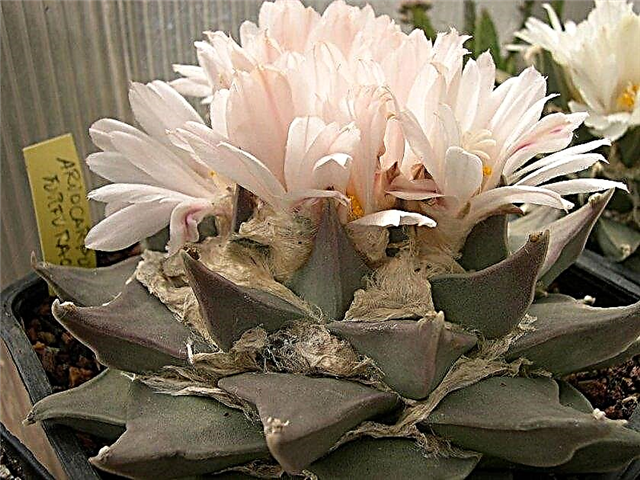
- Cracking ariocarpus - a cactus of a greenish-gray hue. It is unique in that it is perfectly masked in the desert and is not noticeable until it begins to bloom. The shape resembles a placer of small limestone stones. It can be grafted onto a trunk of another species to accelerate growth. Used by Native American shamans to achieve an altered state of consciousness. Almost does not need water and fertilizers, but requires good lighting. Flowering begins at the age of 10 and falls on October.

- Ariocarpus Kotzebue - A plant with a flat rosette in the shape of a star. Usually its height does not exceed 2–5 cm above the ground. It rises in the form of several triangular green tubercles. Cactus is covered with felt crown. Blooms in purple flowers 2.5-5 cm in diameter since mid-September.
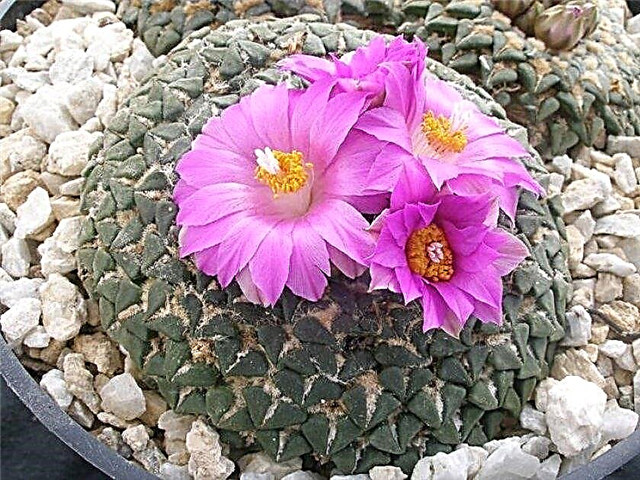
- Ariocarpus triangular is the largest in this group. The diameter of the trigonus reaches 30 cm and a height of 25 cm. The spherical shape of the stem is yellowish-green in color, covered with long-leaved triangular tubercles, sharp at the peaks. The cactus is unique in its variability in the shape and size of the tubercles, therefore it is the owner of numerous names, although they are nothing more than forms or local phenotypes. Satin shine of cream or yellowish flowers is another feature of the species. The diameter of the flower is 3-5 cm. Flowering begins in November or December.

Planting and placing plants in the room
In the wild, ariocarpus grows in rocky areas with the presence of limestone massifs, so limestone is a prerequisite for good development. Fragments of limestone are mixed with solid sand and clay soil. There is little soil between the stones, and this provides a quick outflow of moisture from the roots of the plant.
The material also provides the plant with calcium due to its dissolution in water and the effects of nitrogenous fertilizers. Limestone soils have low acidity (pH 7.0). If your soil is too acidic, apply dolomite instead of ordinary limestone. It consists of magnesium and calcium carbonates, reduces acidity, while providing the plant with calcium and magnesium.Important! During a severe drought, the aerial part of the ariocarpus can shrink and become moldy, but subsequently regrow due to the fact that the root remains alive.

Recommendations for landing ariocarpus:
- You can buy seeds in a store or collect from a seed box after flowering your plant.
- If you are collecting a shift from your cactus, then the seed box must be removed before it dries and the seeds fall into the ground.
- Plant the seeds in a succulent mix. It can consist of compost, perlite and sand in equal parts. Any soil is recommended to be calcined in the oven at high temperature in order to destroy pests and phytopathogens.
- Close the seeds no deeper than 1 cm, or spread on the surface, moisten and sprinkle with sand.
- Cover the container with seeds with cling film to create a microclimate that will accelerate germination by a couple of weeks.
After germination, set the pot on the western or eastern sunny window sill. Sunlight should not be intense and constant. A few hours a day of good lighting are enough. Hanging pots under a shaded canopy are also a great place for tropical succulents.Important! The seeds of some varieties can germinate for longer than 1 month, so do not rush to throw away the soil with planting material.
What kind of lighting is needed for the plant
Plants need a very bright light for optimal growth and development. But do not expose it to direct sunlight. Intense lighting can cause sunburn.
Ariocarpus is best grown:
- in a very bright greenhouse;
- in containers outdoors under bright sunlight.

With a good drainage system, plants can easily tolerate even rainfall, although it may be advisable to install screens to protect against hail. Cacti, which are constantly in the room, suffer from a lack of sunlight and air temperature. In this case, they grow much more slowly and do not bloom.
Requirements for temperature and humidity
Acceptable air temperature - +20 ... + 26 ° С. During the growing season, it should be higher than in the rest of the time. Succulents need very low humidity. In spring and summer, ariocarpus requires good ventilation, but without drafts.
What should be the substrate for planting
The potting mixture for succulents must be loose, permeable to air and sufficiently drained. To do this, mix in equal parts garden soil, compost, perlite, coconut fiber or sawdust.
The purpose of the individual components:
- garden land - this is the soil base of the mixture;
- compost - nutritional component;
- coconut fiber - a structural element that prevents soil compaction;
- perlite provides friability and access of oxygen to the soil.
How to care for an ariocarpus
In order for the plants to develop well, they recreate their natural habitat - the Mexican deserts. They grow well with plenty of light, good drainage, high temperature and low humidity.

Features of watering
There is a common misconception that succulents need very little water. But this is not so. Despite the possibility of moisture accumulation in the stems, with insufficient watering they will survive, but will not develop and thrive.
Since the ariocarpus has very large tuberous roots, all its species are sensitive to excess moisture. This can cause root decay and death if the cactus does not have a good drainage system.
Water the soil as the soil dries with warm water. It is advisable to use rainwater for irrigation. This is due to the fact that heavy metals contained in hard water can accumulate in the soil and manifest themselves as plaque on the walls of the pot and the plant itself. In addition, such minerals interfere with the absorption of nutrients by the ariocarpus.Did you know? Ariocarpus secretes thick mucus, which the indigenous peoples of America used as glue.
Fertilizing and fertilizing the flower
In natural habitats, the ariocarpus receives fertilizers from storm water. Showers are accompanied by thunderstorms. Lightning oxidizes part of the atmospheric nitrogen, which is fed into the ground along with a stream of water. The amount of nitrogen entering the soil can be significant, but the plant will absorb only part of it. And the cactus will get the other part from the polluted air, so your task is to provide it with fertilizers with a low nitrogen content.

The composition also contains potassium and phosphorus. You need to feed the plant once a month from spring to November. The most effective fertilizers for succulents are sodium humate and humic acids obtained from peat and silt. The drugs are released in the form of granules and liquid concentrates. Use the fertilizer strictly according to the instructions on the packaging.
Substances that should be part of fertilizers:
- nitrogen - to enhance growth;
- potassium - to increase disease resistance and good development;
- phosphorus - for root formation and stimulation of flowering;
- calcium - required during the budding and ripening of seeds.
Plant pruning
It is advisable to consider succulent pruning from two perspectives: molding and pruning during transplantation.
Trim the stems of an ariocarpus in order to:
- remove the spikes;
- repair damage from disease, accidental damage.
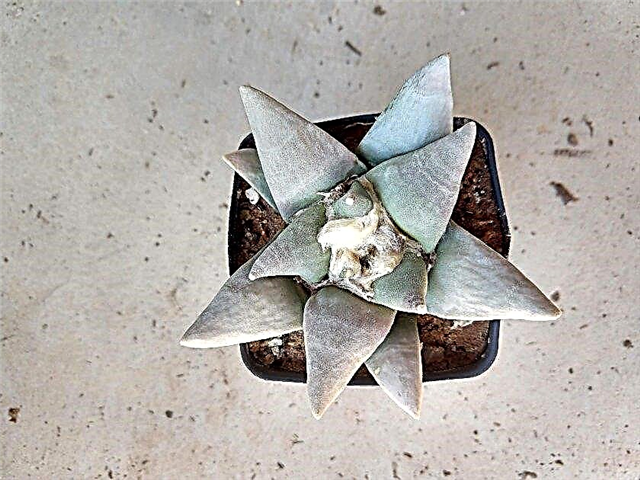
When transplanting, pruning of the roots occurs. Its goal is to stimulate the growth of the root system, reducing the risk of decay of the underground part of the plant. To do this, the roots are trimmed with a sterile knife, then sprinkled with ash and dried for several days before returning the plant to the pot.
But this method has many opponents. Many gardeners believe that such a procedure increases the risk of plant infection by phytopathogens, and its benefits are extremely doubtful. Be sure to prune the flower after flowering and dry the plant under the lamp for 5–10 days to prevent infection with rot or other phytopathogens.
Did you know? Some species of ariocarpus (Ariocarpus retusus and A. Scapharostrus), presumably, are not blooming, although they have all the other features of cacti.
Ariocarpus Transplant Rules
The soil in which the ariocarpus grows, after some time becomes nutrient poor, more dense, therefore, in the spring it is recommended to transplant the plant.
Transplant Instructions:
- Water the cactus liberally so that water flows.
- Tilt the pot over a sheet of paper and carefully remove the plant.
- Tap the old soil with a stick so as not to damage the roots.
- Place drainage (pebbles, gravel, ceramic shards) in a new pot.
- Lay a layer of potted mixture over the drainage.
- Plant an ariocarpus.
- Fill the rest of the pot with soil mixture.

Do not water the plant for several days to prevent rotting of damaged roots. Remember that when transplanting, the natural habitat of the plant is simply recreated: stony soil and an abundance of heat and light.
How to save an ariocarpus in winter
In winter, the ariocarpus is at rest. The air temperature in the room should not be lower than + 10 ° С. Watering is reduced to a minimum. In this case, you should focus on dry soil.
Some gardeners do not water the ariocarpus in the winter months. But in the absence of watering, the root of the neck collapses, followed by cracking, which can cause diseases and death of the plant. There is also a technique for a gradual decrease in watering and a similar gradual increase in spring with the beginning of the growing season.
Ariocarpus breeding
The plant can be propagated by seeds formed after flowering. For growing, you will need a small pot or container, soil made of sand and peat or sheet earth, drainage from pebbles, limestone, and ceramics.

Reproduction Instructions:
- Prepare the soil and drainage.
- Moisten the soil.
- Fill the pot with a layer of drainage, and then mix the soil.
- Sprinkle the seeds on the ground and cover them with a thin layer of coarse sand.
- Spray the soil with a spray gun.
- Cover the mini-greenhouse with foil and place on a sunny warm window sill.
- If condensation forms on the film, it is periodically slightly opened to reduce humidity and prevent mold.
Did you know? The term "cactus" has an ancient Greek origin. For the first time, the word κάκτος was used by Theophrastus, the successor to Aristotle. He designated by this word a certain pricking plant. Since cacti did not grow in Greece, scientists do not know what kind of plant it was.
Plant diseases and pests
Growing an ariocarpus does not require much effort on the part of the grower. With sufficient lighting, well-drained soil and proper watering, cacti will grow and develop well. Nevertheless, diseases can affect any plants.
The most common disease is root rot associated with an improper moisture regimen. Cacti are rotten because they are filled with water and fleshy plant tissue. Rot spreads from the bottom up. It is possible that the root has already decayed, but you will not notice this on the aerial part. Except that rotting succulents have an unpleasant odor.

If you find rot, cut off all the rotten parts with a sterile knife. The remaining healthy part should be light green, as hard as an apple, and not have discolored spots. If they are, then you need to continue to cut. If the tissue is not completely clean, then the plant is thrown away.
When the cactus matures, the lower parts or the base of the plant turn from smooth green to a hard, brown, bark-like look. Such hardening is a sign of natural aging, and it is not a disease. But if the spots appear on the side or top, then this is a sunburn, and the plant needs to be removed from direct sunlight.
If you start growing ariocarpus, then be sure to take care of proper drainage, watering and humidity. And always focus on the natural habitat of this succulent. In this case, you will definitely be able to grow a beautiful houseplant that will delight you with flowering annually.Did you know? The tallest cactus grown as a houseplant reached a height of 33.5 m. It is grown at the Dentists College in Dharvada, Karnataka, India.The record was recorded by the Guinness Book of Records in July 2015. At the same time, the cactus itself was planted in August 2002.






